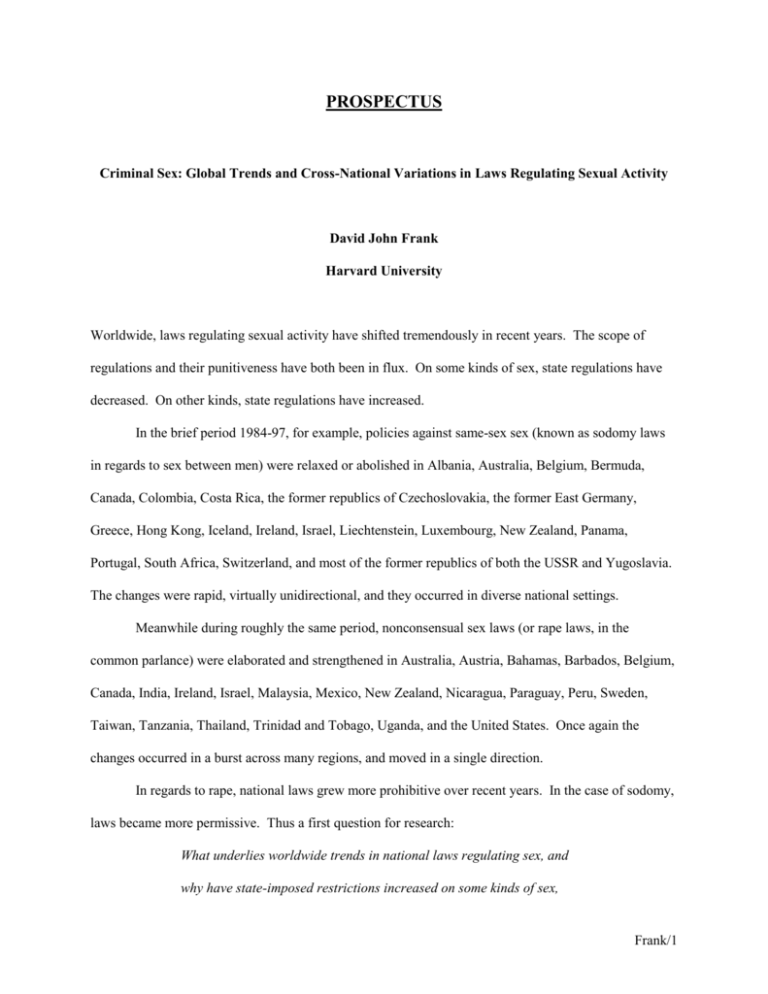
PROSPECTUS
Criminal Sex: Global Trends and Cross-National Variations in Laws Regulating Sexual Activity
David John Frank
Harvard University
Worldwide, laws regulating sexual activity have shifted tremendously in recent years. The scope of
regulations and their punitiveness have both been in flux. On some kinds of sex, state regulations have
decreased. On other kinds, state regulations have increased.
In the brief period 1984-97, for example, policies against same-sex sex (known as sodomy laws
in regards to sex between men) were relaxed or abolished in Albania, Australia, Belgium, Bermuda,
Canada, Colombia, Costa Rica, the former republics of Czechoslovakia, the former East Germany,
Greece, Hong Kong, Iceland, Ireland, Israel, Liechtenstein, Luxembourg, New Zealand, Panama,
Portugal, South Africa, Switzerland, and most of the former republics of both the USSR and Yugoslavia.
The changes were rapid, virtually unidirectional, and they occurred in diverse national settings.
Meanwhile during roughly the same period, nonconsensual sex laws (or rape laws, in the
common parlance) were elaborated and strengthened in Australia, Austria, Bahamas, Barbados, Belgium,
Canada, India, Ireland, Israel, Malaysia, Mexico, New Zealand, Nicaragua, Paraguay, Peru, Sweden,
Taiwan, Tanzania, Thailand, Trinidad and Tobago, Uganda, and the United States. Once again the
changes occurred in a burst across many regions, and moved in a single direction.
In regards to rape, national laws grew more prohibitive over recent years. In the case of sodomy,
laws became more permissive. Thus a first question for research:
What underlies worldwide trends in national laws regulating sex, and
why have state-imposed restrictions increased on some kinds of sex,
Frank/1
even as they have decreased on other kinds?
Regardless of broad world-level trends such as these, striking cross-national variation in the legal
regulation of sex remains. There are no restrictions on adultery in the laws of Ecuador and Botswana, for
example, while adultery may be punished with imprisonment in the laws of Nicaragua (up to two years)
and Bangladesh (up to five years). Thus a second research question:
What are the sources of persistent cross-national variation in national laws
regulating sex?
These two questions, along with an interest in the mechanisms of regulatory change, the implementation
of sex laws, and the agency of nation-states in legal reform, orient the proposed book.
Introduction
The book’s introductory chapter is devoted to establishing the main sociological problems, laying out the
central arguments, and introducing the laws and policies I plan to study. The problems, as noted above,
are twofold. We live in a world in which sex laws are changing rapidly, with some kinds of laws
tightening across all sorts of countries and some kinds of laws loosening across all sorts of countries.
Simultaneously, we live in a world in which considerable cross-national variation in sex laws persists,
regardless of any global trends.
The key to the two patterns lies in change and variation in the composition of “society.” At the
world level, society is becoming more individualized – the individual is increasingly seen to be the root
building block of social life, free from the constraints of family, nation, and religion. Simultaneously,
however, there remains variation in the extent to which nation-states retain strong emphasis on the more
corporate entities as basic actors and accounting units. Societies composed of individuals as primordial
elements undertake different kinds of sex regulations from those composed of families, nations, and
religious bodies as elemental units. This is because sex takes on different meanings at the two poles of
the continuum. Where its locus is the family, the nation, or religion, sex tends to be about procreation.
Where its locus is the individual, sex becomes more expressive and pleasure-oriented in meaning. The
kinds of sexual activities that are threatening and thus warrant legal regulation vary accordingly.
To make this case, I focus on four kinds of laws, two more problematic in the individualized
context and two more problematic in the corporatized context. (1) Child sexual abuse. The greater the
extent to which society is organized around individuals, the greater the extent to which nation-states
should mobilize to protect those deemed less able to govern their own free bodies, children being the
primary example. (In more corporatist settings, by contrast, children are largely subsumed in private
realms, removed from direct state protection.) The overall prediction is that the legal regulation of adultchild sex will be higher with higher levels of individualization. (2) Rape. In family-, nation-, and religionbased societies, nonconsensual sex is an important but narrow threat to virginal girls and family bloodlines.
In individualized settings, rape has much broader ramifications as a violation of individual bodily
sovereignty. My general expectation is that the national state regulation of nonconsensual sex will
positively covary with the individualized personhood. (3) Adultery. Extramarital sex threatens the
paramountcy of procreative sexuality, and thus carries significant public relevance in family-, nation-,
and religion-based social systems. In more individualized systems, by contrast, extramarital sex has
fewer public ramifications. My general expectation is that the state regulation of extramarital sex will
decrease with the individualization of society. (4) Sodomy: Same-sex sex operates against procreation,
and thus appears as threatening in corporatist societies. In individualized settings, however, same-sex
sex is merely a taste or preference or orientation, and publicly inconsequential. Thus I expect the overall
state regulation of same-sex sex to be lower under conditions of higher individualization.
Each kind of law (on adultery, rape, child sexual abuse, and sodomy) has two basic dimensions: its
scope, defining the acts and actors covered by the law; and its punitiveness, establishing the legal
sanctions applied to offenders. Both dimensions are crucial. Laws-on-the-books, even when they are
poorly enforced, may be highly consequential as symbols in society. Thus I plan to study both
dimensions of all four kinds of laws, aspiring to collect complete data for about 125 nation-states for the
time period 1945 to the present.
Chapter 1: Global Trends
The book’s first main chapter focuses on global trends in the national state regulation of sex. The core
idea is that global blueprints of “society” have become increasingly individualized in recent decades – a
trend captured most clearly in the rise of human rights – leading to worldwide shifts in the nature, focus,
and extent of sex laws.
Since the liberal victory in World War II, global blueprints of society have grown increasingly
individualized. The choices of individuals in the voting booth, institutionalized in democracy; the
decisions of individuals in the marketplace, institutionalized in capitalism; and the understandings of
individuals in everyday life, institutionalized in mass education and science all embody the global trend.
Human rights and women’s rights further reflect the individual’s rising centrality as the main motivators
and beneficiaries of society. The global process, together with a concomitant crumbling of the corporate
bases of society (the nation, the family, and the church), has gone at least some distance to
individualizing society in all kinds of countries throughout the world.
I expect world-level individualization to generate new understandings of sex and new templates for
its regulation by the state, undermining the legitimacy of nation-based, family-based, and church-based sex
laws and enhancing the legitimacy of those founded on the individual in all kinds of countries. Evidence of
the shift should appear in the changing scope and punitiveness of sex laws. In regards to the more
corporate-based sodomy and adultery laws, I expect individualization to lead to lower restrictions (fewer
actors and actions defined as criminal, weaker penalties for the crime). In the cases of the more individualbased child-sexual-abuse and rape laws, I expect higher restrictions. For example, the scope of rape laws
might expand to include new kinds of persons who can perpetrate and fall victim to nonconsensual sex.
Gender neutralization may appear (such that men and boys gain protection), and husbands may lose legal
access-on-demand privileges to their wives. Furthermore, the range of activities defined as rape may
expand, from physically forced vaginal sex to verbally resisted sex of any kind. Persons deemed vulnerable
(i.e., unequal by reason of physical or mental impairment or subordinate position) may receive enhanced
protections, as those least able freely to give consent come to be seen as requiring special protections. And
the legally offended party may shift from the husband or father to the offended individual. Likewise, the
punitiveness of nonconsensual sex laws should increase. In particular, the punishment of rape should cease
to vary with hierarchical distinctions between virgins, wives, divorcees, and prostitutes, and criminal
penalties should generally increase. Personal boundary violations such as those represented by rape should
generate harsh reprisals in individualized systems.
The global story provides the broadest view on the ways models of “society” underlie national laws
regulating sex. The next step is to nuance the picture with an investigation of cross-national variation.
Chapter 2: Cross-National Variation
World-level individualization alters the environment within which nation-state policies on sex are
constituted. But the global institutional environment is not alone in providing either blueprints of society or
the building blocks of national sex policies. Here I emphasize two other warehouses of social reality:
religious traditions and polity types. Models of society and its compositional units are distributed from
each, and they produce considerable cross-national variation in sex laws, regardless of the wider global
trends.
First, different religious heritages involve different models of society’s composition, and thus
underlie variation in national laws regulating sex. At two poles of a continuum are countries with Protestant
heritages, which have the most strongly individualized foundations, and countries with Buddhist and Hindu
heritages, which have more corporate foundations. Religious traditions are particularly important as
pertains to sex, since religion historically played a dominant role in the social (as opposed to state)
regulation of sex, and since national sex policies often incorporate religious ideologies. Especially in
countries where civil and religious authorities still openly intermingle (most vividly the Islamic cases),
religious institutions even now retain definitive roles vis-à-vis the nation-state and sex.
Second, different polity types carry different models of society’s elemental units and thus shape
the intersections of states and sex. In particular, the more classically liberal polities grant great standing
to individualized persons, and countries with such polities likely give more emphasis to individual-based
and less emphasis to family-, nation-, and religion-based sex laws. This may be true not only among the
European countries, where polity types are sharply distinguished, but also in lesser developed countries,
where colonial legacies form the basis for cross-national variations in legal structures around sex. Penal
codes typically derive directly, even verbatim, from the colonial power. For example, the adult-child sex
laws of countries as distant as Botswana and Dominica are almost exactly the same – a fact arising from
the common English roots of their penal codes.
Evidence of cross-national variations comes from the same sources as above. The scope and
punitiveness of national laws on rape, adultery, child sexual abuse, and sodomy should all vary according
to individualization. Where the corporate entities form the basic building blocks of society, adultery and
sodomy laws should be harsher. Where the individual is basic, laws on child sexual abuse and rape
should be stronger.
Both of these institutional environments – polity type and religious heritage – underlie the persistent
cross-national variation so striking in the state regulation of sex. But the main propeller of change, I
anticipate, is global. (If it is otherwise, the observed global trends will not be “trends” at all but simply
change in different directions.) This opens several important questions that lead to a further narrowing of
the book’s lens. (1) If national laws are in fact constituted within a larger global institutional environment,
by what mechanisms does the constitution take place? (2) If national laws are constituted in world society,
to what extent are they actually implemented domestically? (3) If the driving forces of change in sex laws
are global, what place is there for the agency of nation-states?
Chapter 3: Thailand
To answer such questions, I turn to the case level, where I will study the specific ways changes in the
global institutional environment (i.e., the rise of individualistic blueprints in world culture and
organization) propel national level statutory changes and then what happens once the changes are made.
I expect the gears of reform to be turned mainly by global arbiters of “truth,” such as scientists, experts,
and professionals. These, more than the usually fingered emissaries of power, have the authority to
reconstitute society around individuals (in the forms of democracy, capitalism, scientific education,
human rights, and so on). Thus they should serve as the main conduits between world society and the
nation-state.
For evidence, I will interview government officials, social-movement activists, legal experts,
law-enforcement officers, and others with first-hand knowledge of the state regulation of sex. I will
focus the interviews on the three main questions named above, concerning mechanisms, implementation,
and the agency of nation-states.
The composition and reform of sex laws should be especially interesting among countries outside
the developed West, where less scholarly work has been done and where institutional conflicts between
global and national structures are likely to be most evident. Thus I will conduct case studies of Thailand,
Pakistan, and Poland.
First up is Thailand, one of the few countries in the world never to have been colonized. As
such, Thailand lies outside many global networks of direct influence. Its penal code, in particular, may
be more original than the penal codes of other countries. Furthermore, Thailand is a Buddhist country,
and thus contains many institutions celebrating the centrality of the family and other corporate entities,
rather than the individual. Finally Thailand is a global center of commercial sex tourism, a fact that may
skew its laws in particular directions.
For all these reasons, Thailand may not follow broader global trends. If in fact it does, the
mechanisms promoting change should be clearer than they would be in a national environment more
closely articulated with the global environment. [Note: a draft of the Thailand chapter is attached.]
Chapter 4: Pakistan
Having established the determinants of sex policy in Thailand, I turn my attention to a very different but
equally interesting case. Pakistan is an Islamic country, under pressure from religious conservatives and
from some other Islamic countries to flout any reconfiguration of sex laws around the individual and
pleasure. Indeed conservative religious leaders in Pakistan have sought to take over the regulation of sex
entirely, replacing the civil law with Islamic law. What’s more, Pakistan is politically unstable – its basic
integrity is threatened from several quarters, which may inhibit the flow of individualized models of
society (in the form of human rights, say) and thus slow the transformation of sex laws.
Accordingly, Pakistan may not embody shifts in sex laws seen elsewhere in the world. Conflict
between the global and national institutional environments is likely to be sharply evident.
Chapter 5: Poland
While there are reasons to believe Thailand and Pakistan will resist global trends in the national
regulation of sex, Poland may be expected to embrace them tightly. Poland underwent major changes in
1989, shifting its allegiances quickly and dramatically from the Soviet Union to Western Europe. This
meant that the old Soviet model of society, in which the individual is subordinated to the nation, rapidly
gave way to the extreme individualism institutionalized in the European Union. As part of this process,
the modern individualist institutions – especially democracy and the free-market – swept into Poland.
Thus, sharp changes in the Polish sex law may be expected. (At the same time, however, the Catholic
church regained prominence in Polish society after 1989. The culture and organization of the church
may conflict with global institutions.)
Given its general move over the last decade, Poland is likely to embrace the global trends with a
vengeance. Seeing just how this happens will help us understand the more general processes by which
individualized models of society at the global level reform national policies on sex.
Conclusion
Changes and variations in national sex laws are striking. The three-tiered approach outlined above –
moving from global trends to cross-national variations to case-level changes – aspires to provide a rich
and complex picture of the transformations at hand.
The study builds on the notion that institutionalized definitions of actors and activities constitute
the basic features of social life. In recent times, these definitions increasingly have been organized on a
global scale, and they increasingly depict society’s elemental actors to be nation-states founded on highly
individuated persons, with sharp boundaries and wide autonomy. These processes underlie broad
transformations in national laws regulating sex. What was once publicly legitimate mainly for the
purpose of reproduction in the family is now legitimate for individual pleasure. By studying nation-state
regulations on rape, adultery, sodomy, and child sexual abuse from 1945 to the present in many countries
around the world, I can put these arguments to the test. By layering the analyses, I can provide a full
picture of the processes by which state regulations have changed.
What seems clear at the outset is that state policies on sex are in a period of rapid flux, appearing
to move out of some areas and into others. But much remains in question. What is the precise nature and
extent of the flux, and why is it occurring? The book outlined above sets out to offer one set of answers.
Appendix: Changes in National Penal Codes 1945 to the Present
In an appendix, the proposed book will summarize the main changes in the scope and punitiveness of
laws on rape, adultery, child sexual abuse, and sodomy. No comparable summary of sex law exists, and
the data may be useful to other scholars. The data are culled directly from country penal codes.
Examples appear in the coding document attached.
AUDIENCE, LENGTH, SCHEDULE
I intend to write the book at the level of advanced undergraduates and above. It will be suitable for
courses in the Sociology of Sexuality, the Sociology of Law, and Globalization. I also expect the book to
have some popular audience, mostly from social-movement participants – those promoting human rights,
women’s rights, children’s rights, and the rights of sexual minorities.
The main text will be approximately 200 pages, with a total of about 20 illustrations (figures and
tables). The appendix, if the press elects to include it, will take another 50 pages or so. I expect a draft
of the book to be completed by the end of 2002. I am on sabbatical during the whole of 2001 and will be
able to devote myself entirely to the project.








